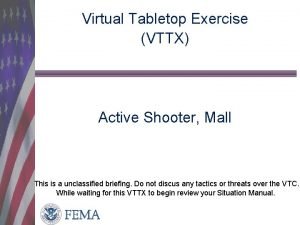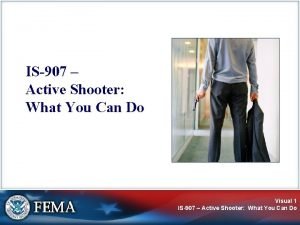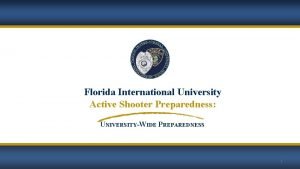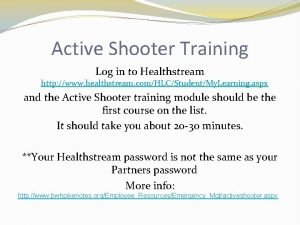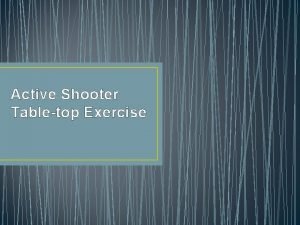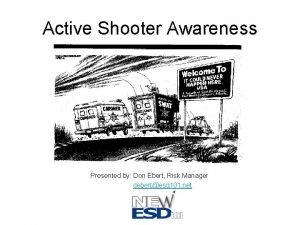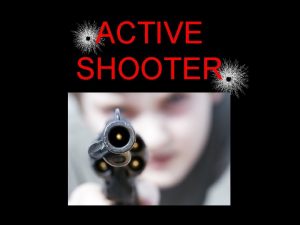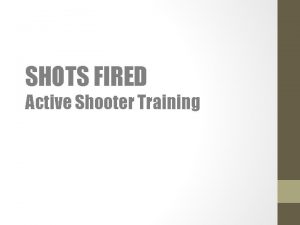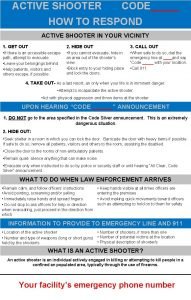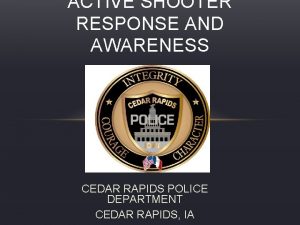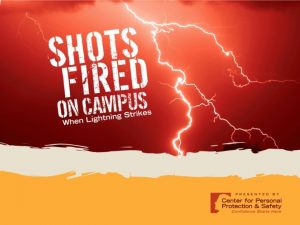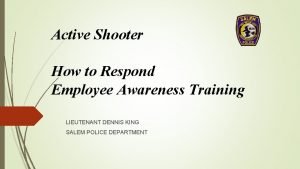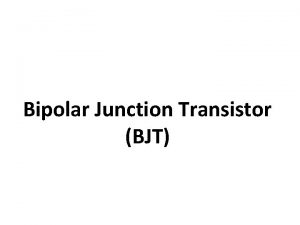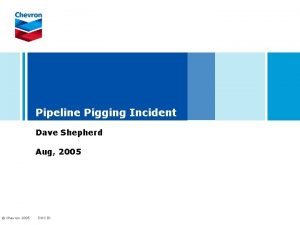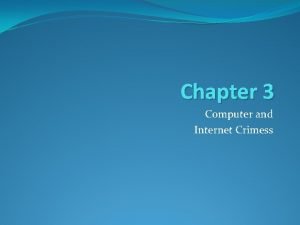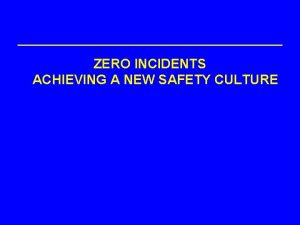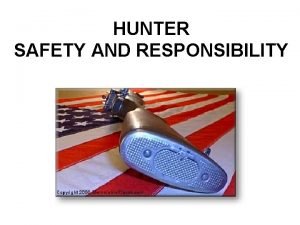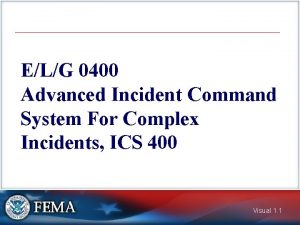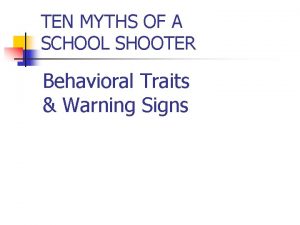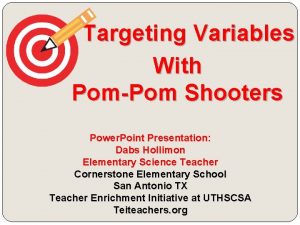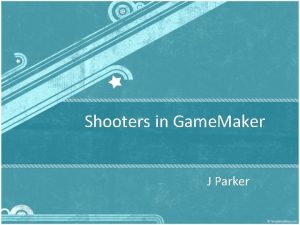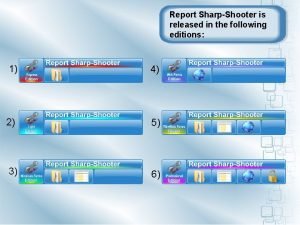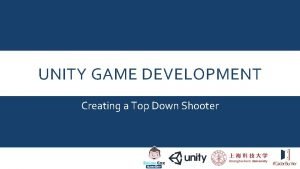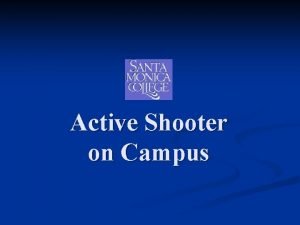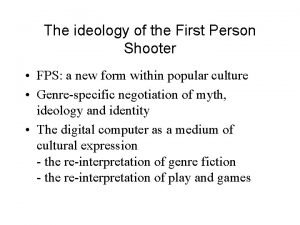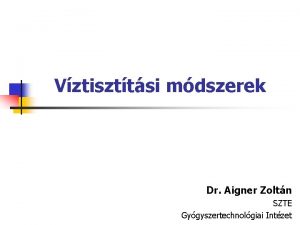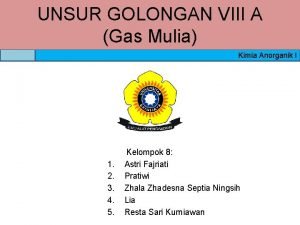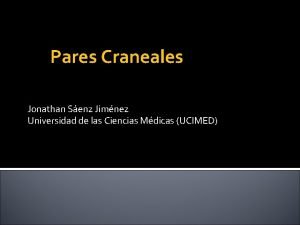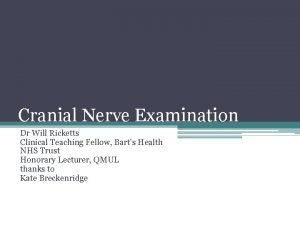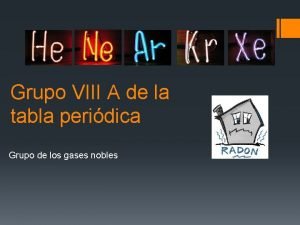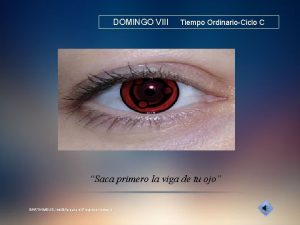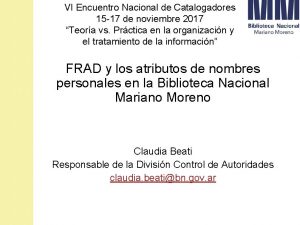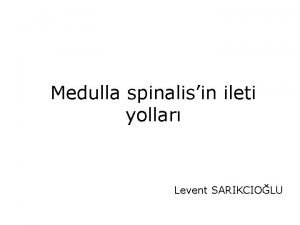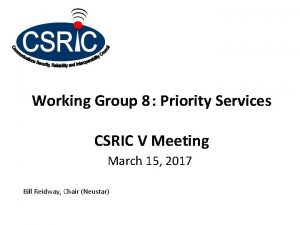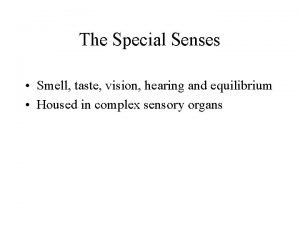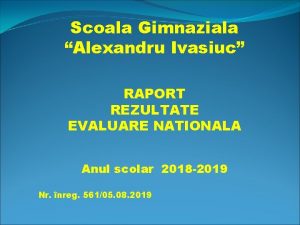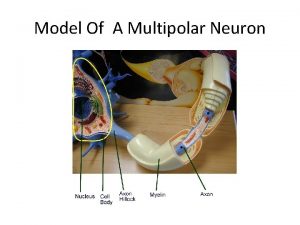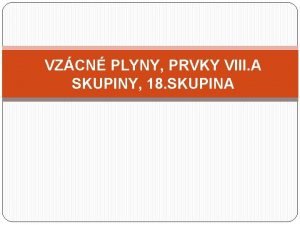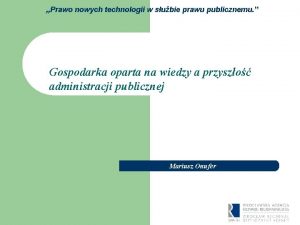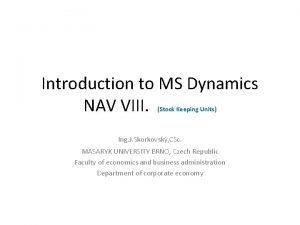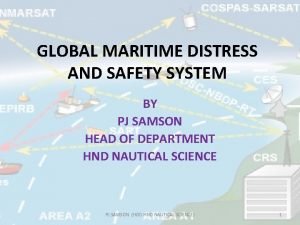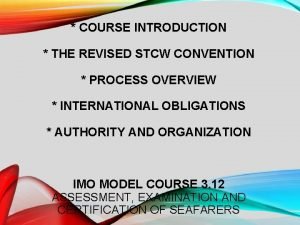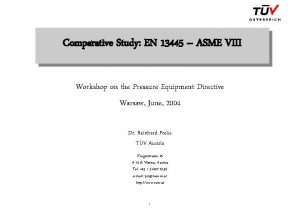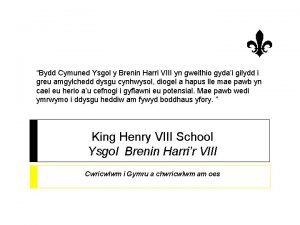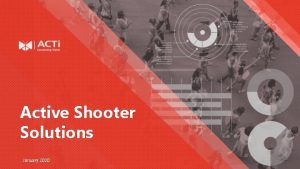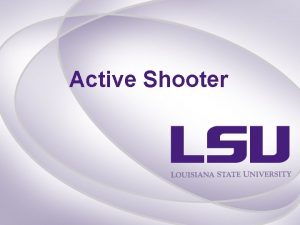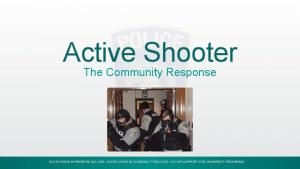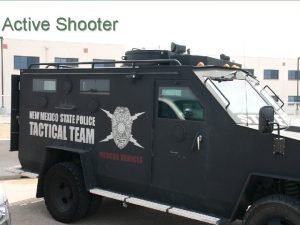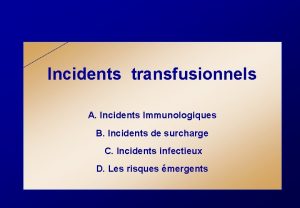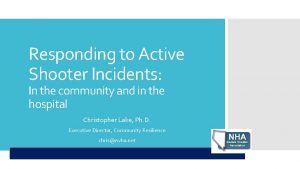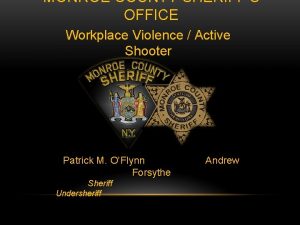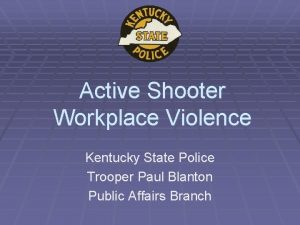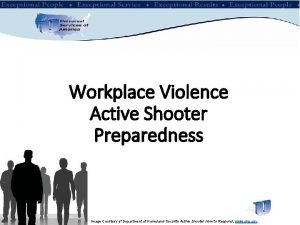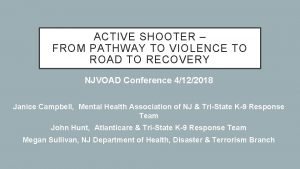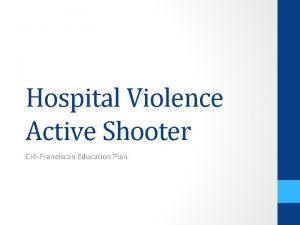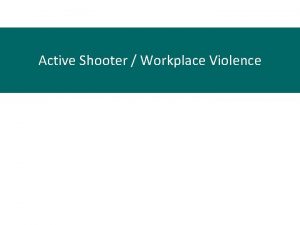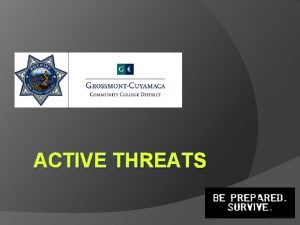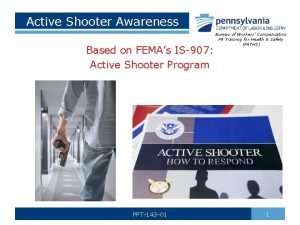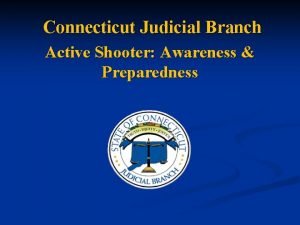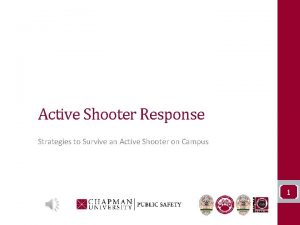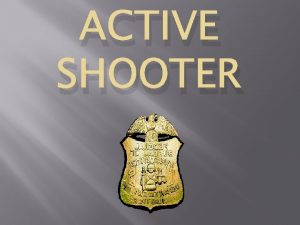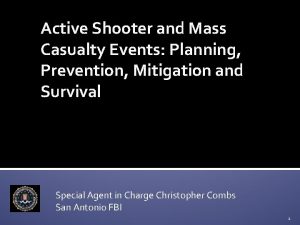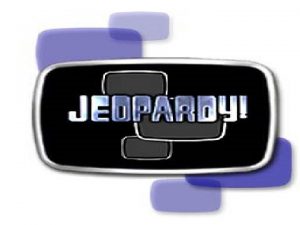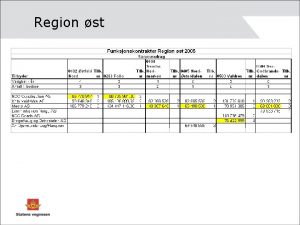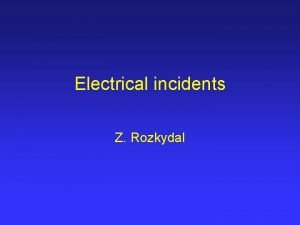Active Shooter Mass Violence Incidents Region VIII EMS




























































































- Slides: 92

Active Shooter / Mass Violence Incidents Region VIII EMS – September 2016

Objectives • Definitions • Statistics • Injury patterns • Treatments

Objectives • Science of coagulopathy • What is the role of the PD • Four legged responders (K 9) • Post traumatic stress

Note • Active shooter, Rescue Task Force, and Tactical Emergency Medicine are in and of themselves intensive subjects that require multiple days of didactic and practical training. This education module is designed to touch upon those topics and provide some general knowledge in each of the areas. It is in no way wholly inclusive for any of these subject areas and is not designed nor intended to replace or replicate those training regiments.


Active Shooter • What is it? “An individual(s) actively engaged in killing or attempting to kill people in a confined and populated area. ”

Statistics • FBI has identified 160 active shooter incidents between 2000 and 2013


Statistics • On average 11. 4 incidents annually – 6. 4 on average incidents between 2000 -2006 – 16. 4 on average between 2007 -2013 • 70% occurred in commerce or educational environment • 60% ended prior to police arriving

Statistics • Casualties – 486 killed – 557 wounded • 64% of incidents considered “mass killings” – Defined as 3 or more killed • 25% of incidents involve multiple locations

Shooters • All but 2 incidents involved a single shooter • In at least 6 incidents shooters were female • 40% of shooters committed suicide • 28% of shooters exchange gunfire with police

Shooters 46. 7% of officers that engaged the threat sustained a gun shot wound…

Self Check • Items to consider for your service area… – How does a shooter in multiple locations complicate department responses? – How do officers racing towards the gunfire change dynamics of response? – If the location is a school vs. an office, how is the emotionality of the response affected? • What if it’s your child’s school?

What if this happened in your town? How close is too close?

Notable Incidents • Cinemark Century 16 Theater – 70 (12 killed, 58 wounded) • Virginia Tech – 49 (32 killed, 17 wounded • Ft. Hood Texas – 45 (27 killed, 2 wounded) • Sandy Hook Elementary – 29 (27 killed, 2 wounded)

Century Theater Shooting

Century Cinemark Theater • Aurora Colorado • Active shooter in a crowded theater • 70 victims total – First officer arrived in 83 seconds – First ambulance in 3 minutes – First fire unit in 5 minutes

Century Cinemark Theater Lessons Learned: What went well… – Patient distribution to local hospitals – Family reuniting center quickly established – Psychological care for first responders – All patients triaged and transported rapidly – All patients that were transported survived

Century Cinemark Theater Lessons Learned: Areas of improvement – Communication • Unified Command • Fire Department Incident Command • Fire Police Communications

Century Cinemark Theater Lessons Learned: Areas of improvement – Risk assessment • EMS did not know shooter was detained – Access to victims • Medic units unable to get close due to congestion • Transportation group never established – Triage tags not utilized • Difficulty in prioritizing patient transport

Century Cinemark Theater Lessons Learned: Areas of improvement – First Responder Relief • Days following attack – Victim Information • Issues with accurate and timely information for families

Injury Patterns and Treatment

C. A. B. C. • Active shooter / Mass violence – Different mindset • Catastrophic hemorrhage • Airway • Breathing • Circulation

Causes of Death #1 – Hemorrhage #2 – Tension Pneumothorax #3 – Airway Obstruction

Injury Patterns • Hemorrhage – #1 preventable cause of death on the battlefield • 66% of preventable deaths!!! – Various Control Methods • • Direct Pressure dressings Hemostatic dressings Tourniquets

Injury Patterns Clinical presentations of acute hemorrhage: Class % Blood Loss Clinical Signs I Up to 750 ml Slight increase in HR; no change in BP (15%) or respirations II 750 -1500 ml Increased HR and respirations; (15 -30%) increased diastolic BP; anxiety, fright or hostility III 1500 -2000 Increased HR and respirations; fall in ml (30 -40%) systolic BP; significant AMS IV >2000 (>40%) Severe tachycardia; severe lowering of BP; cold, pale skin; severe AMS

Hemorrhage Control • Tourniquets – Safe and effective • No longer taboo! – 10+ years of proven battlefield use – Police officers • Must carry… – Medics • Should carry…

Hemorrhage Control • Tourniquets – For life threatening hemorrhage – First line for life threatening arterial bleed – Not just for active shooter – Can remain in place up to 8 hours

Hemorrhage Control • Hemostatic Agents – Impregnated gauze – Packed into wound – Used for area where tourniquets cannot reach – Used for less serious/stepdown care

• "Stop the Bleed" is a nationwide campaign to empower individuals to act quickly and save lives. ”

• Public access bleeding control kit • Emerging concept

Science of Coagulopathy • Stopped the bleeding… More fluid? – “Replace what the patient has lost” • If blood has been lost, give blood (hemorrhage) • If crystalloid has been lost, give crystalloid (dehydration) – But what about my two large bore IV’s? ! • Not so fast… “Prehospital Intravenous Fluid Administration is Associated with Higher Mortality in Trauma Patients: A National Trauma Data Bank Analysis”

Science of Coagulopathy Is Too Much Fluid Bad? ? ? Two large bore IV’s infusing WO Reverses Vasoconstriction Dislodges Clots Hypothermia Coagulopathy MORE BLEEDING!!! Hemodilution Reduced O 2 Delivery Acidosis

Science of Coagulopathy • Bottom line… – IV fluids • Penetrating trauma – Little to no benefit – Can cause increased mortality • Blunt trauma – Neither good nor bad • So what do we do? – Judicious use of fluids to maintain good MAP pressure

MAP Pressure 2 x Diastolic + Systolic / 3 Given: BP 120/80 Given: BP 90/60 (2 x 80) + 120 = 280 (2 x 60) + 90 = 210 280 / 3 = 93. 3 MAP of 93. 3 210 / 3 = 70 Map of 70 A MAP of 65 is needed to maintain perfusion to vital organs… Brain, heart, lungs, kidneys…

Tension Pneumothorax • What is it? • When do we treat it? • Sometimes misdiagnosed • 33% of battlefield deaths.

Tension Pneumothorax • 3” needle minimum is new standard • 2” needle shown to be ineffective

Tension Pneumothorax • Insertion site – Midclavicular • 2 nd/3 rd intercostal space – Midaxillary • 5 th/6 th intercostal space – Which is better?

Airway Obstruction • 6% of preventable deaths • Think simple first! – Especially when you have multiple victims • Nasal Airway • Oral Airway • Recovery position

Recovery Position

Hypothermia • Is the enemy in the hypovolemic trauma patient • Blood is the body’s heat transport system • Patients can quickly become hypothermic – Profound effects on clotting • Room temperature IV fluids exacerbate • Keep patients warm!

Blast Injuries

Blast Injuries • Blast Lung – Most common fatal injury – Can happen as late as 48 hours after – Clinical triad • Apnea • Bradycardia • Hypotension

Blast Injury • Ear Injury – Frequently overlooked, but not usually fatal • Abdominal injury – Gas filled organ – Susceptible to pressure wave – Suspect in patients with • Abdominal pain/GI pain • Testicular pain • Hypotension

Blast Injury • Brain Injury – TBI • Abrupt changes due to trauma • Can affect personality – One minute normal, next minute not • • Brain heals differently No two are alike Individual may not be aware they have TBI Can be immediate onset or delayed weeks

Traumatic Brain Injury • Mild – <30 minutes loss of consciousness, confusion, or disorientation – Profound future effects on mood, emotion, attention span – Even though mild, can still be devastating • Severe – – >30 minutes of the loss of consciousness Memory loss Penetrating skull injury Impaired physical abilities

Active Shooter Training ALERRT /Rescue Task Force

ALERRT • Advanced Law Enforcement Rapid Response – Why? • In response to active shooter incidents • Developed in 2002 – What • First arriving officer to engage shooter even if alone. • Bypass victims to engage shooter

ALERRT • What does this mean for you? – Victims may be police and bystanders – Officers are your first line of treatment once threat is neutralized • Tourniquets – What is your plan of action when the officers go racing in to confront the threat?

ALERRT Conference • Active shooter conference • Brings together police and EMS – Rescue task force and police training

Rescue Task Force Teams deployed to provide point of wounding care to victims where there is an on-going ballistic or explosive threat

Rescue Task Force • Change from the norm of “EMS is staging till scene secure” – EMS entering warm zone with armed escort • Cleared but not secure area – Treatment of victims • Basic, rapid care! – Hemorrhage control (Tourniquets, hemostatic) – Not the time for ALS care – Evacuation of victims • Logistically and physically exhausting • Time consuming

Rescue Task Force • Assigned in groups – 2 (treatment) – 4 (movement) • Casualty collection point • Armed protection – 2 police • Warm Zone

Rescue Task Force • Typical Gear – Tourniquets – Pressure Dressings – Chest Seals – Chest Darts – Ballistic protection • Level IIIa vest • Helmet

Rescue Task Force • DHS guidelines for active shooter events – Full Document • RTF Demonstration https: //youtu. be/_dj Fz. Ej. Zuh 8

Rescue Task Force • Fire, EMS, and LE MUST train together!! – Develop local protocols – Utilize unified command – Incorporate TECC – Provide appropriate protective gear – Consider secondary devices/IED – Common terminology – Train, train

TCCC vs. TECC • TCCC – Tactical Casualty Combat Care • Developed for military • TECC – Tactical Emergency Casualty Care • Civilian adaptation of TCCC • Phases of care • Utilized by rescue task force and TEMS

Tactical Emergency Casualty Care • Direct Threat Care – Care during active fire fight • Usually performed by officer or TEMS member – Basic emergent care! I. E. Tourniquets! • Indirect threat care – No longer a threat to the casualty • Still basic care but more time to assess • Evacuation care – Care phase when victim is being removed from the building

TEMS vs. RTF TEMS – Tactical Emergency Medical Support – Works directly with SWAT – In the hot zone – Primary task is SWAT members health – Can become RTF once threat is mitigated – Trained in SWAT tactics and nomenclature RTF – Works with police • Unified Command – Operates in the warm zone – Primary task is civilian casualties • Victim removal

Everyday Body Armor • Local decision • Cost factor • Does your response area dictate the need • Stab vs. Ballistic protection.

K 9 Care

Treatment of K 9’s • Specialized Dogs – Drug sniffing – Bomb sniffing – Sight Seeing – PTSD – Seizure – Therapy – Search and Rescue

Dogs, can we treat them? • Yes… To a certain extent… Humane Care for Animals Act Sec. 16. 5. Emergency care to an animal; immunity from civil liability. Any person, including without limitation any person licensed under the Veterinary Medicine and Surgery Practice Act of 2004 or licensed as a veterinarian in any other state or territory of the United States, who in good faith provides emergency care or treatment without fee to an injured animal or an animal separated from its owner due to an emergency or a disaster is not liable for civil damages as a result of his or her acts or omissions in providing or arranging further care or treatment, except for willful or wanton misconduct.

Dog’s, what kind of treatment? • Keep it basic and non-invasive! – Bandaging – Basic oxygenation – Irrigation – CPR • Do not perform advanced skills – IV – Medications

Animal Care • Government Working Dogs – Consider an agreement – Government asset/property • Pets – No contracts – Private Property • Bottom line, if you don’t feel comfortable caring for animal, there is no legal recourse for not providing care.


• Post traumatic Stress Disorder – Common in EMS – Can occurs months after – Doesn’t have to be related to one large incident – Can be due to years of critical stress – MUST have proper structure, support, and guidance to know when, how, and where to seek help

PTSD

PTSD

PTSD

PTSD – How one FF/Paramedic is recovering… JEMS Article Link – PTSD

Scenario 1 You are dispatched for the active shooter at a local office building. Three arriving officers on scene report the threat is down and there a total of 7 victims in the building. As you gather equipment to enter for treatment, what do you want to consider bringing? What other resources will you need? How will you coordinate and communicate with officers on scene?

Scenario 1 • Dispatcher Considerations – How many calls can you call center handle at one time? – What happens when calls overload the system? • Put them on hold automatically? • Will them simply get a busy signal? – How will an active shooter situation affect your dispatch centers resources?

Scenario 1 • On scene you have 2 greens with minor abrasions. • 2 victims are conscious and have GSW to the arms with copious dark red hemorrhaging • 2 victims have GSW to the legs are responsive to pain, pale, with copious bright red bleeding • 1 victim is unresponsive with a GSW to the chest breathing 4 times per minute

Scenario 1 • Which patients are your priorities? • What are your best treatment options for each? • Are there any resources immediately available to help treat and move patients? • How will you evacuate your patients?





START Triage


Scenario 2 • You are dispatched to the report of an active shooter at a local mall. There are reports of multiple victims in multiple locations throughout the mall. As you arrive on scene officers have already made entry and killed the shooter. As you pull up you find 18 victims outside. Some walking around, some sitting, and some lying down in various areas of the parking lot yelling at you for help….

Scenario 2 • What is your next action? – Do you take medical command/triage? – Or do you begin treatment/transport? • What are your treatment priorities in this situation? • What resources in your response area are en route? And what others will you need to call?

Scenario 2 As you begin operations outside, officers inside the building state there are 20 GSW victims including young children throughout the mall. • What is your next course of action? • Can you communicate with police in your area? • Do your officers have the ability to render aid until more help arrives?

Scenario 2 • How will you move all of these victims? • Do you now have two separate areas of treatment and triage?

Skills of the Month • BLS – Review system specific procedure for tourniquet application.

Skill of the Month - ALS • EZ-IO – 15 g needle • LD 45 mm • AD 25 mm • PD 15 mm • Utilize for – Arrest – Impeding arrest – System specific

EZ-IO • Site: – Humeral Head (Preferred) • LD needle – Preferred needle for humeral head! • Greater flow rates (5 L per hour) • Right into subclavian – Faster into central circulation – Proximal Tibia • Needle choice is patient dependent • Slower flow rate (1 L per hour) • Often selected due to provider familiarity

EZ-IO • Always give a rapid flush when establishing access! – No flush = No flow • Always flow fluids under pressure! – ~300 mm. Hg – If pressure isn’t maintained there is a risk of flow stoppage.

Medication of the Month • Normal Saline – 0. 9% • Isotonic • p. H of 4. 5 to 7. 0 – Indications • • Vascular access Fluid replacement Irrigation Stable croup

Rhythm of the Month • Asystole – Without systole – Determine and treat underlying causes - Hypovolemia - Hypoxia - Hypo/ Hyperkalemia - Hypoglycemia - Hypothermia - Tamponade - Tension pneumothorax - Thrombosis - Toxins

Asystole SOP!
 Active region and saturation region
Active region and saturation region Active shooter tabletop exercise
Active shooter tabletop exercise Is 907 active shooter
Is 907 active shooter Fiu active shooter training
Fiu active shooter training Run hide fight
Run hide fight Healthstream active shooter
Healthstream active shooter Active shooter tabletop
Active shooter tabletop Active threat assessment lifetime fitness
Active threat assessment lifetime fitness Active shooter defined
Active shooter defined Extreme danger gap
Extreme danger gap Active shooter code
Active shooter code Active shooter tabletop
Active shooter tabletop Active shooter cedar rapids
Active shooter cedar rapids A survival mindset is comprised of which three components
A survival mindset is comprised of which three components Active shooter healthstream
Active shooter healthstream Intermuscular spaces
Intermuscular spaces Bjt
Bjt Bjt transistor
Bjt transistor How does nick characterize the guests at gatsby’s party?
How does nick characterize the guests at gatsby’s party? Pipeline pigging incidents
Pipeline pigging incidents Roorkit
Roorkit Zero safety incidents
Zero safety incidents Safety rule violations can cause hunting
Safety rule violations can cause hunting Mulan plot diagram
Mulan plot diagram Advanced incident reporting system
Advanced incident reporting system The author's arrangement of incidents in a story
The author's arrangement of incidents in a story School shooter traits
School shooter traits Pom pom shooter
Pom pom shooter Shooter game maker
Shooter game maker Report sharp shooter
Report sharp shooter Unity top down shooter tutorial
Unity top down shooter tutorial Nnn shooter
Nnn shooter Kill heel mbti
Kill heel mbti Eric harris photos
Eric harris photos First person shooter ideology
First person shooter ideology And or boolean
And or boolean Membrane structures that function in active transport
Membrane structures that function in active transport Primary active transport vs secondary active transport
Primary active transport vs secondary active transport Aqua destillata pro injectione
Aqua destillata pro injectione Sifat xenon
Sifat xenon King henry vii family tree
King henry vii family tree Nc viii
Nc viii Henry viii wives executed
Henry viii wives executed Catherine medici family tree
Catherine medici family tree Augusburgo
Augusburgo Cn 8 testing
Cn 8 testing Prc br 435 – code of ethics for professional teachers
Prc br 435 – code of ethics for professional teachers Reforma luterana consequências
Reforma luterana consequências Henry viii great matter
Henry viii great matter Henry viii banquet menu
Henry viii banquet menu Xenón grupo
Xenón grupo Viii domingo ordinario ciclo c
Viii domingo ordinario ciclo c Domingo xviii tiempo ordinario ciclo c
Domingo xviii tiempo ordinario ciclo c Henry viii definition ap world history
Henry viii definition ap world history Roma siglo viii a.c
Roma siglo viii a.c Viii encuentro nacional de catalogadores
Viii encuentro nacional de catalogadores Spinovisual refleks
Spinovisual refleks Berikut adalah dampak langsung reformasi gereja, kecuali?
Berikut adalah dampak langsung reformasi gereja, kecuali? Csric viii
Csric viii Henry viii divorce catherine of aragon
Henry viii divorce catherine of aragon Did catherine parr have children
Did catherine parr have children Yanylion
Yanylion Raport simulare evaluare nationala 2021
Raport simulare evaluare nationala 2021 Cn viii
Cn viii Faustino viii
Faustino viii Carlo martello dante
Carlo martello dante Macculae
Macculae King henry viii gardena
King henry viii gardena Prvky 18. skupiny
Prvky 18. skupiny Viii henrik feleségei
Viii henrik feleségei Henry viii deathbed painting
Henry viii deathbed painting San faustino 2020
San faustino 2020 Luther calvin and henry viii
Luther calvin and henry viii Roman numerals n
Roman numerals n Luther calvin and henry viii
Luther calvin and henry viii Henryk viii
Henryk viii Jnc 8
Jnc 8 Viii
Viii Henry viii great matter
Henry viii great matter Henry viii foreign policy 1509-1529
Henry viii foreign policy 1509-1529 Reflexões do poeta canto viii
Reflexões do poeta canto viii How to remember king henry viii wives
How to remember king henry viii wives How to remember henry viii wives
How to remember henry viii wives Circular unica sic titulo viii
Circular unica sic titulo viii Nav viii
Nav viii Navarea viii warnings
Navarea viii warnings Standards governing the use of simulators diatur dalam
Standards governing the use of simulators diatur dalam En 13445 vs asme viii
En 13445 vs asme viii Module viii
Module viii Harri viii
Harri viii Limiting reactant definition
Limiting reactant definition Isotopic mass formula
Isotopic mass formula Relative formula mass of hcl
Relative formula mass of hcl

